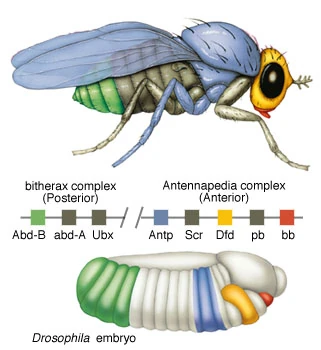
Evolutionary Development

Fig. 1 Hox gene expression in Drosophilla, illustrating the positions of the genes in the embryo and their corresponding adult structures which are expressed.
EVO -DEVO
Evo- devo (evolutionary developmental biology) refers to the branch of evolutionary biology which investigates how developmental processes evolved. These processes create the embryonic template which map adult structures. The breakthrough in this field came about because of the discovery of a group of regulatory genes known as the homeotic “hox” gene family,( Kutschera & Niklas 2004; Levine2001). All cells in an organisms body carry the same genes, however these genes are differentially expressed, for example the globin gene which produces red blood cells is triggered by a hox gene to be expressed in the blood but not in the skin (Levine 2001).
Evidence[]
These genes have been found in arthropods (insecta, myriapoda, and chelicerata) and vertebrates. The genes encode for a DNA binding protein which are used in the transcription process. Transcription is the process by which RNA is produced from the DNA map. The RNA’s are responsible for protein synthesis. The genes represent a family of genes which share a common DNA code and operate during the blastocyst stage before cells are differentiated. The fruit fly gene homeotic gene - Antennapedia was the first homeotic gene discovered in the centre of the fruit fly embryo and it is associated with the development of the thorax. This breakthrough led to the discovery of a series of homeotic genes which controls expression of other body parts in Droosphilla (See Fig 1 which illustrates the positions of the Hox genes on Drosophilla and their relation to the adult structures). It has also been discovered that all living organisms from earthworms to humans share common homeotic gene segments, suggesting that these genes are strongly conserved (Meyer 1998, Levine 2001, Kutschera & Niklas 2004).
References[]
References:
Kutschera, U. & Niklas, K. (2004). The modern theory of biological evolution: an expanded synthesis. Naturwissenschaften 91:255–276.
Levine, M. (2001). Basic Body Plans: interview with Mike Levine. Nova Evolution, Show 2 – Great Transformations. Retrieved October 27th 2013 from: http://www.pbs.org/wgbh/evolution/library/04/4/text_pop/l_044_20.html
McGraw Hill Higher Education (2013). Retrieved October 27th from: http://www.mhhe.com/biosci/genbio/olc_linkedcontent/j_enhancement/r_43-2.htm
Meyer, A. (1998). Developmental biology: Hox gene variation and evolution. Nature 391, 225-228